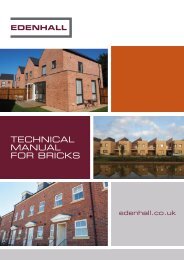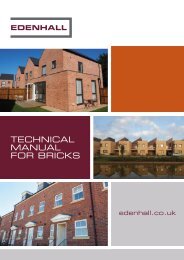You also want an ePaper? Increase the reach of your titles
YUMPU automatically turns print PDFs into web optimized ePapers that Google loves.
HSDS 1<br />
HEALTH & SAFETY DATA SHEET<br />
PRODUCT HAZARDS<br />
This Data Sheet is a formal notification as required by Section 6 of the Health & Safety at Work Act, as amended by the<br />
Consumer Protection Act 1987. This legislation requires us to provide customers with certain information pertaining to the<br />
properties and safe use of our products. It is important that this information is distributed to all relevant personnel and/or subcontractors<br />
or other parties employed by yourselves in the handling and use of these materials.<br />
PRODUCTS<br />
Precast concrete and masonry products manufactured and marketed by <strong>Edenhall</strong> comprise of Bricks, Blocks, Architectural Cast<br />
Stone Dressings and Structural and Bespoke Precast items.<br />
They are produced from the normal constituents of concrete, and when presented in their normal form and manner are unlikely to give<br />
rise to any significant risk to health. The normal constituents are:<br />
• Natural and Artificial Aggregates<br />
• Cementing Agents<br />
• Additional Binders<br />
• Non-Toxic Iron Oxide Pigments<br />
• Steel Reinforcement<br />
• Steel Fixings<br />
PHYSICAL AND CHEMICAL CHARACTERISTICS<br />
Precast and masonry concrete products are manufactured to fine tolerances by the compaction and/or vibration of a hydrated mix<br />
of constituent materials which subsequently undergo a curing process. Concrete of this nature can be considered to be inert and<br />
therefore presents no major chemical hazard.<br />
MAIN HAZARDS<br />
The handling of concrete products may cause abrasive damage to the hands. Excessive handling may cause dermatitis or drying of<br />
unprotected skin.<br />
Manual handling should only take place where the weight of the unit(s) permits, otherwise injury may occur. Weights of products are<br />
available from the supplying works.<br />
Cutting, drilling, grinding or similar treatment of the products will give rise to respirable dust. Such dust, if inhaled in excessive<br />
quantities over extended periods, can constitute a long-term health hazard. Cutting, unless adequately controlled, can project<br />
particles at high velocity, with consequent risk of impact damage. Steel reinforcement, which may be integrated into some precast<br />
units, may constitute a fire hazard from the resultant sparks if the units are to be cut. Wet cutting processes minimise the dust<br />
exposure, however the product appearance may be affected. Dry cutting processes will require appropriate and adequate dust<br />
extraction and protective equipment.<br />
CLEANING AND MAINTENANCE<br />
Periodic cleaning may be carried out by washing with water and mild detergents, using soft brushes. For more assertive cleaning refer<br />
to specialist concrete cleaning agencies.<br />
Aggressive cleaning with high pressure washers and/or diluted acids will leave units with a coarser texture which will change the<br />
apparent colour.







